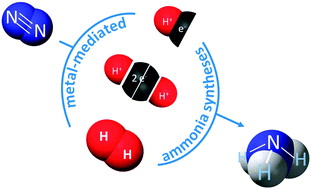Mechanistic aspects of dinitrogen cleavage and hydrogenation to produce ammonia in catalysis and organometallic chemistry: relevance of metal hydride bonds and dihydrogen
Abstract
Dinitrogen cleavage and hydrogenation by transition-metal centers to produce ammonia is central in industry and in Nature. After an introductory section on the thermodynamic and kinetic challenges linked to N2 splitting, this tutorial review discusses three major classes of transition-metal systems (homogeneous, heterogeneous and biological) capable of achieving dissociation and hydrogenation of dinitrogen. Molecular complexes, solid-state Haber–Bosch catalytic systems, silica-supported tantalum hydrides and nitrogenase will be discussed. Emphasis is focused on the reaction mechanisms operating in the process of dissociation and hydrogenation of dinitrogen, and in particular on the key role played by metal hydride bonds and by dihydrogen in such reactions.


 Please wait while we load your content...
Please wait while we load your content...